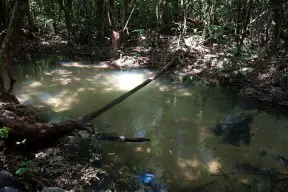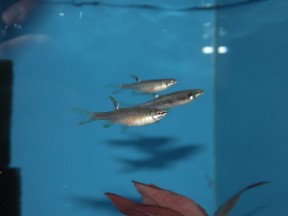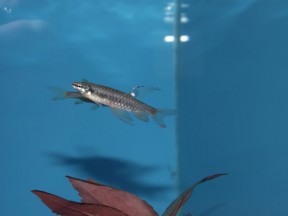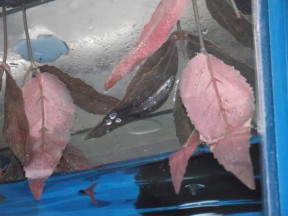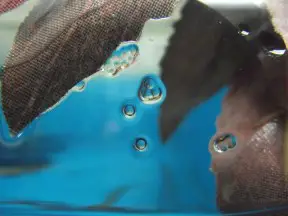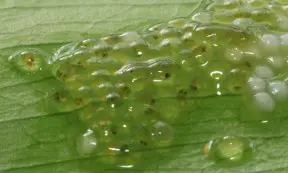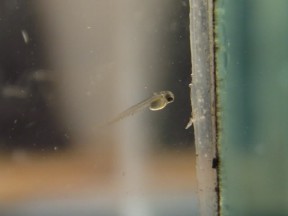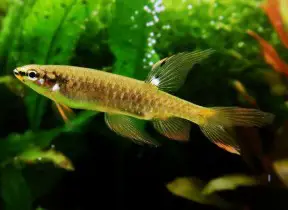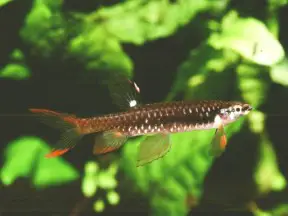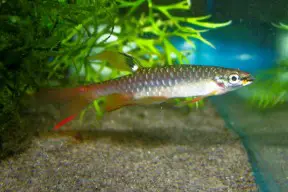Copella arnoldi
Splash Tetra
SynonymsTop ↑
Copeina arnoldi Regan, 1912
Etymology
Copella: a diminutive of the generic name Copeina which was named for naturalist Edward Drinker Cope (1840-1897).
arnoldi: named for J. Paul Arnold, who collected the type specimens and donated them to the British Museum.
Classification
Order: Characiformes Family: Lebiasinidae
Distribution
Type locality is given simply as ‘Amazon’ by Regan and most modern reports state that this species is widely-distributed in the lower Amazon basin in Brazil plus coastal drainages of Guyana, Suriname and French Guiana including the Demerera, Essequibo, Suriname and Nickerie.
It exhibits a degree of variation in certain aspects of morphology and colour pattern across this range, however, and Zarske (2011) considers populations from the Guianas to represent C. carsevennensis (Regan, 1912), implying that C. arnoldi sensu stricto is restricted to the lower Amazon basin.
Zarske (2011) also designates an alternative ‘type locality’ of Ilha do Arapiranga which is an island in the Amazon estuary located close to the city of Belém in Pará state, eastern Brazil, from where aquarium specimens are apparently collected.
This does not appear to qualify as a neotype locality since no corresponding neotype designation is included, however.
See the ‘Notes’ section for further information on C. carsevennensis.
Habitat
Mostly inhabits streams and minor tributaries and occurs in flooded forests during periods of high water.
Its most-favoured habitats are characterised by large amounts of overhanging riparian vegetation and the water is often stained the colour of weak tea due to substances released by decomposing organic matter.
Maximum Standard Length
45 – 55 mm.
Aquarium SizeTop ↑
Surface dimensions of 90 ∗ 30 cm or equivalent should be the minimum considered for long-term care although smaller aquaria can be used for breeding.
Maintenance
Best kept in a densely-planted aquarium or paludarium with some overhanging vegetation, roots or branches important if you wish to raise fry alongside the adults (see ‘Reproduction’).
Floating vegetation is also useful since this species appears to prefer relatively dim conditions and spends much of its time in the upper part of the water column.
The addition of dried leaf litter further emphasises the natural feel and as well as offering additional cover for the fish brings with it the growth of microbe colonies as decomposition occurs.
These can provide a valuable secondary food source for fry and the tannins and other chemicals released by the decaying leaves are also considered beneficial for fishes from blackwater environments. Alder cones may also be used for the latter purpose.
The water should be well-oxygenated with a little surface agitation advisable.
Do not add this fish to a biologically immature aquarium as it can be susceptible to swings in water chemistry.
Water Conditions
Temperature: 20 – 28 °C
pH: 4.0 – 7.5
Hardness: 18 – 143 ppm
Diet
A micropredator feeding on tiny invertebrates and other zooplankton in nature, especially at the water surface.
In the aquarium it will accept dried foods of a suitable size but should also be offered daily meals of small live and frozen fare such as Artemia nauplii, Moina, grindal worm, etc.
Small insects such as crickets or Drosophila fruit flies are also suitable to use although it’s best to fill the stomachs of these by feeding them fish flakes or some kind of vegetable matter before offering them to the fish.
Behaviour and CompatibilityTop ↑
Peaceful but somewhat unsuitable for the general community aquarium.
It’s perhaps best-maintained alongside similarly-sized characids, gasteropelecids, lebiasinids, smaller callichthyid or loricariid catfishes and diminutive, non-predatory cichlids.
Try to buy a mixed-sex group of at least 8-10 specimens, include other schooling fishes to provide security, and you’ll be rewarded with a more natural-looking spectacle.
Males will also display their best colours and some fascinating behaviour as they compete with one other for female attention.
Sexual Dimorphism
Males grows significantly larger, develop more-extended fins and are more colourful than females.
In nuptial males a broad dark band may extend posteriorly along the body from behind the opercle.
Reproduction
Displays an interesting reproductive strategy in which spawning and egg deposition occurs on overhanging vegetation above the water surface.
In a mature set-up it’s possible that small numbers of fry may start to appear without intervention but should you wish to maximise yield a more controlled approach using a separate tank is preferable.
This can be arranged very simply with an air-powered sponge filter, plenty of floating plants and a gap of around 10 cm between water surface and cover.
You can also use emerse vegetation if you wish although the fish aren’t fussy and will depoit their eggs on almost any suitable surface, including the side of the aquarium or cover glass.
The site is selected by the male and he may be seen repeatedly leaping out of the water as he searches for a suitable spot.
Once a site has been chosen the male attempts to attract females in the vicinity and at the climax of courtship the pair jump out of the water and cling onto the spawning site using their pelvic fins.
They may remain in place for up to 10 seconds or so as eggs and milt are released.
10-12 eggs are typically deposited during a single event and the process is repeated until the female is spent with total brood size normally 100-200.
The female now plays no further part in broodcare and can be removed but the male remains in the vicinity and keeps the eggs moist by using his caudal-fin to splash water at them, this behaviour ceasing during the hours of darkness.
On occasion a pair will deposit eggs in several places or a single male may spawn with several females and thus must maintain several batches of eggs simultaneously.
The splashing is repeated every minute or so and continues for the next 36-72 hours until the eggs hatch at which point the fry simply drop into the water.
At this point paternal care ceases and adults or fry are best moved elsewhere in order to avoid predation.
Initial food should be Paramecium or a proprietary dry food of sufficiently small (5-50 micron) grade, introducing Artemia nauplii, microworm, etc., once the fry are large enough to accept them.
As with other Copella spp. growth is very slow.
NotesTop ↑
This species is also known as the ‘spraying’, ‘splashing’ or ‘jumping’ tetra and these names are sometimes applied to its congeners although none of them exhibit a comparable spawning strategy, rather depositing their eggs among vegetation at or around the water surface.
It can be told apart from other Copella spp. by the following characters: 23-24 scales in the lateral row; presence of a dark stripe running from the tip of the snout to the eye; dorsal-fin insertion located closer to the caudal-fin base than the posterior edge of the opercle; no black triangular marking in the ventral rays of the lower caudal-fin lobe.
Some forms have more brightly-coloured fins while at least one displays a broad midlateral stripe when preserved, and those from Guyana, Suriname and French Guiana are considered to represent C. carsevennensis (Regan 1912) by Zarske (2011).
Following the latter author C. arnoldi is told apart from C. carsevennensis by: presence (vs. absence) of a silvery-white to white patch in the centre of some of the flank scales in males, particularly in the lower half of the body; presence (vs. absence) of a horizontal dark body bar in nuptial males; presence (vs. absence) of thin black margins in the dorsal, ventral and anal fins; eggs deposited outside of the water (vs. eggs deposited among submerged vegetation.
Mol (2012) considers the two species synonymous based on a personal communication although no detailed explanation is given so we continue to list them separately for the time being.
The genus Copella can be told apart from the closely-related Pyrrhulina by aspects of head morphology plus possession of only one (vs. two) row of conical teeth in the premaxillary.
The family Lebiasinidae is included in the order Characiformes and sometimes split into the nominal subfamilies Lebiasininae and Pyrrhulininae, though there has not been a major review of the grouping in recent times.
All lebiasinid genera possess a relatively long, elongate body shape with 17-33 scales in the lateral series and laterosensory canal system absent or reduced to 7 scales or less.
Some species have an adipose fin while others do not, and the anal-fin has a relatively short base of 13 scales or less.
In the majority of members males have an enlarged or otherwise well-developed anal-fin used in courtship and spawning.
The frontal/parietal fontanelle is always absent, the cheek well-covered by the orbital and opercular bones, the supraoccipital crest is absent, and the scales of the dorsal body begin over the parietal bones.
Characiformes is among the most diverse orders of freshwater fishes currently including close to 2000 valid species distributed among 19 families.
This tremendous taxonomical and morphological diversity has historically impaired the ability of researchers to resolve their genetic relationships with many genera remaining incertae sedis.
A further limiting factor has been that in many cases exhaustive study of these on an individual basis is the only way to resolve such problems.
Modern molecular phylogenetic techniques have allowed some headway, though, and a research paper by Calcagnotto et al. published in 2005 revealed some interesting hypotheses.
Their results suggest that Lebiasinidae forms a trans-atlantic, monophyletic clade alongside the families Ctenoluciidae and Hepsetidae, this clade further forming a sister group to Alestidae.
Others such as Oliveira et al. (2011) have concluded that the family Erythrinidae is also closely-related to this grouping with Hepsetidae and Alestidae more distant.
References
- Regan, C. T., 1912 - Annals and Magazine of Natural History (Series 8) v. 10 (no. 58): 387-395
A revision of the South American characid fishes of the genera Chalceus, Pyrrhulina, Copeina, and Pogonocharax. - Calcagnotto, D., S. A. Schaefer, and R. DeSalle, 2005 - Molecular Phylogenetics and Evolution 36(1): 135-153
Relationships among characiform fishes inferred from analysis of nuclear and mitochondrial gene sequences. - Géry, J., 1977 - T.F.H. Publications, Inc.: 1-672
Characoids of the World. - Mol, J. H. A., 2012 - Brill Academic Publishers: 1-890
The Freshwater Fishes of Suriname. - Reis, R. E., S. O. Kullander and C. J. Ferraris, Jr. (eds.), 2003 - EDIPUCRS, Porto Alegre: i-xi + 1-729
Check list of the freshwater fishes of South and Central America. CLOFFSCA. - Zarske, A., 2011 - Vertebrate Zoology 61(1): 13-45
Beiträge zur Kenntnis der Vertreter der Gattungen Pyrrhulina VALENCIENNES, 1846 und Copella MYERS, 1956 des nordöstlichen Südamerika (Teleostei: Characiformes: Lebiasinidae). - Zarske, A. and J. Géry, 2006 - Zoologische Abhandlungen (Dresden) 56: 15-46
Zur Identität von Copella nattereri (Steindachner, 1876) einschließlich der Beschreibung einer neuen Art (Teleostei: Characiformes: Lebiasinidae).

